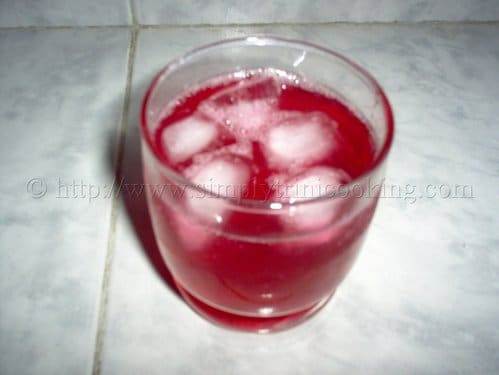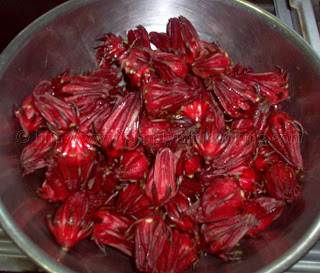Sorrel drink is a drink to enjoy during Christmas. In Trinidad and Tobago, the sorrel plant is a household name, however it gets more attention during the Christmas season when its edible petals are used to make one of our favorite Christmas drinks, simply called “sorrel“.
This drink is affectionately called by other names reflecting its country origin. For example, in Latin America, it is referred to as agua de flor de Jamaica; in North Africa, it is called karade; and in the ivory coast, this red beverage is called da bilenni (where the plant itself is called “da”). However, most people only think that this plant is useful only to make this drink. For this reason, the rest of the flower is discarded without much thought. Now, you will be surprised as to the value and wide use of this popular plant.
In Trinidad the sorrel drink is popular during Christmas.
The Sorrel Plant
The sorrel I speak of is the one commonly referred to as “roselle” or, by its botanic name, “hibiscus sabdariffa Linn.”. This sorrel or roselle is a species of hibiscus. It is a member of the plant family, Malvaceae.
This tropical or subtropical shrub is referred to by other names, such as rozelle, sour-sour, Queensland Jelly plant, jelly okra, lemon bush, and Florida Cranberry. In Egypt and North Africa it is called karkad Other African countries such as Mali, Gambia, Nigeria, Namibia and Senegal refer to it as dah, wonjo, zobo, omulete and bissap respectively. In the Indian subcontinent, it is called mesta. Some other names are chin baung, saril, and rosela. Spanish speakers refer to it as quimbomb³ chino, sereni, rosa de Jamaica,and agrio de Guinea.
The sorrel plant grows to a height of 1.5 to 3 meters. It has many branches and its flowers bear annually. It stalks are green or red coloured; but the edible calyx or sepals of the flower varies from red to pale yellow. The red colour of the calyx varies depending on the geographic origins of the plant and the composition of the soil. If you wish to cultivate a sorrel plant, here are some things you should know.
The plant is well suited for tropical climates where rainfall is well-distributed. For this reason, the sorrel plant is mostly found in India, Africa, Saudi Aribia, Sudan, Egypt,the East Indies, the Caribbean and Mexico.The sorrel plant requires about 13 hours of sunlight in the first month – this ensures that the plant do not flower prematurely. However, it can tolerate warmer and more humid climates.
This plant also requires night time temperatures to not drop below 21 C. Frost and fog can damage it. Don’t worry about it being in the open, the sorrel plant can tolerate heavy winds. The soil should be permeable, sandy with humus, but free from weeds. If you are cultivating this plant due to its commercial interest, you should note that it reaches maturity within 4 months.
The brillant red calyces of the sorrel flower is used to make a variety of dishes.
Cooking with Sorrel
The sorrel or roselle type (hibiscus sabdariffa L.) is most exploited for its calyces and fiber. The commercial interest of this crop is mostly in its red pigmented calyces. The calyces are separated from its capsules by hand or with the use of a simple hand-held gadget. The brilliant red colour and unique …. flavour of the sorrel or roselle calyx makes it useful in food preparation. The calyx is used to prepare herbal drinks, teas, beverages, jams, jellies, syrup, marmalades, wine, gelatin, pudding, cakes, ice cream, sherbets, butter, pies, sauces, tarts, desserts, etc. It is definitely a useful flavouring or colouring.
The green calyx is also used in food preparation. Besides the calyx, the sorrel seed is also used in cooking.
Commonly the seed from the sorrel flower is discarded. But the seed, like many other types of seeds such as corn, sunflower seeds, and cocoa, etc. can also be very useful – such as in food preparation, as poultry feed, and to make scrubs and soaps. In many African and Eastern countries, edible oil is extracted from the seed. The balance is used to season a number of dishes. The seed is also a substitute for coffee. However, the sorrel seeds and calyces can also offer other benefits as well.
Here are some handy tips when cooking sorrel.
1. Try not to use an aluminum or cast iron pan when cooking sorrel as it impairs the flavour.
2. Remove the stalks before cooking, they don’t taste so good.
3. Try this delectable herb in some of your favorite recipes.
The Nutrition Value of Sorrel
Nutritionally, it’s calyces have higher amounts of ascorbic acid than guava and orange (about 100g more). The calyces has three times more vitamin C than black currant and nine times more than citrus fruit. It’s orangy to red colour pigment offers a good source of antioxidant. Thus, sorrel calyces has been known to treat high blood pressure, heal sores and ulcer. Its seeds are high in protein, dietary fiber, and minerals (such as phosphorus, magnesium, and calcium). The seeds also have aphrodisiac properties. In countries such as Myanmar, the seeds are used as a diuretic, a laxative, and a tonic.
The sorrel is indeed a versatile flower and very useful in food preparation. It is a perfectly healthy flavoring option and natural substitute for food colouring. It is available in many places where it is grown fresh and in large quantities in the market. It is also available in a dried form. You might be able to find dried sorrel petals in Chinese groceries and in a Caribbean supermarket near you. So, the next time you make your favorite sorrel drink, you might consider there might just be more other meals you could make with this versatile flower. Even better, share your cooking ideas for sorrel with us here on this page.
Listed below are the nutrients that make up this food item:
Sorrel Petals (fresh)
Moisture 84.5%
Serving Size 100 g
Calories 49 kcal
Calories from fat
Total Fat 0.1 g
Sodium 6 mg
Total Carbohydrate 12.3 g
Dietary Fiber 2.3 g
Protein 1.9 g
Vitamin A 287 IU
Vitamin C 14 mg
Vitamin D 2.84 ug
Vitamin B1 0.04 mg
Vitamin B2 0.6 mg
Vitamin B complex 0.5 mg
Beta carotene 300 mg
Calcium 1.7mg
Phosphorus 57 mg
Iron 2.9 mg
Note: Nutrition information for Roselle seeds are not readily available. However, Roselle or sorrel seeds have a high protein-content.

Sorrel Drink
Ingredients
- 1 lb. sorrel
- 11 cups water
- 1 cup sugar granulated
- 2 sticks cinnamon
- 5 cloves optional
- 4 tbsp. grated ginger
- 1/4-1/2 cup rum optional
Instructions
- Wash the sorrel. Separate the sepals from the ‘seed’. Wash the sorrel sepals again. Place in a deep pot and add the water, cinnamon, and optional spices.
- Boil for about 20 minutes or until the sepals begin to lose their colour and look jelly-like. Strain the sorrel and allow to cool. After it cools, sweeten with sugar and add the rum if desired.
- Transfer to a sterilized bottle and refrigerate. Serve chilled



In Guadeloupe we call it ‘grozey’ in patois. Like in Trinidad we cook sorrel specialy for christmas, in syrup or jam to drink with rum.